Briefly: In our opinion, speculative short positions (full) in gold, silver and mining stocks are justified from the risk/reward point of view.
We finally saw a week in which gold, silver and mining stocks declined and the key question is if the decline is over or was this just a natural correction within a new powerful rally. The reply to this question is quite critical as it has profound implications. Let’s discuss once again what’s likely going on.
Although a lot happened in the past few weeks, from the long-term perspective, little changed and, in our opinion, what has been taking place is yet another corrective upswing within a bigger downtrend. We have yet to see confirmations that the final, major bottom is in.
Let’s take a look at the details (charts courtesy of http://stockcharts.com).
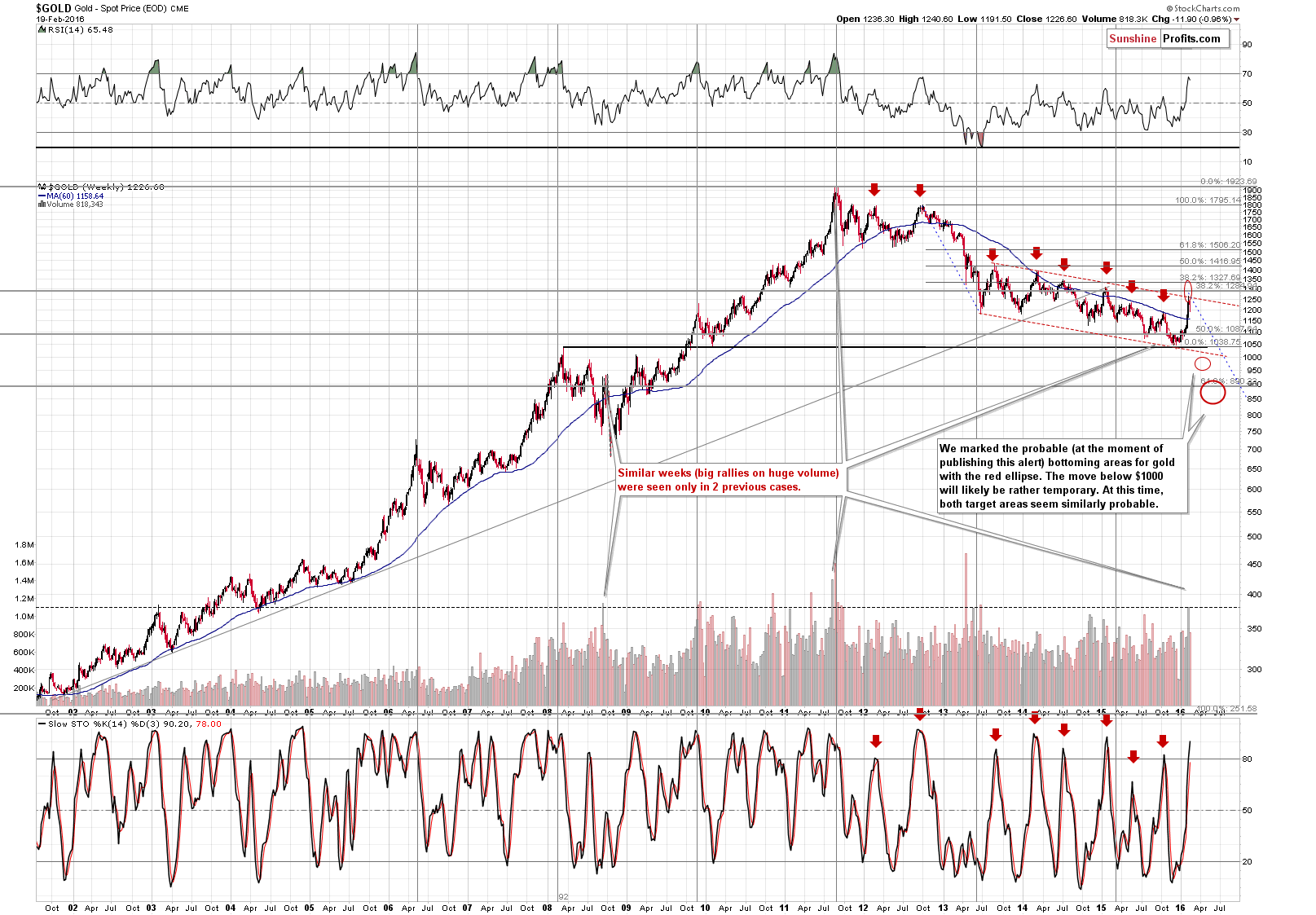
Regarding the above chart, our Wednesday’s comments remain up-to-date:
From the long-term perspective, gold appears to have topped. It moved to the upper border of the declining trend channel and reversed. The reversal was seen on huge volume and in the previous cases when similar volume was seen, gold plunged in the following weeks. However, in both most similar cases (late 2008 and 2011 tops) gold moved higher to re-test the previous highs. We don’t think a move this big will be seen as the rally was to a large extent based on the incorrect reading of what Janet Yellen had said about NIRP (thus the rally was somewhat random and artificial) and this factor is not likely to be repeated, however, a move higher from here might still be in the cards (it’s not very likely, though).
Since we wrote the above gold has indeed moved higher once again, but, as you can see on the following chart, this corrective upswing was in tune with the previous tops.
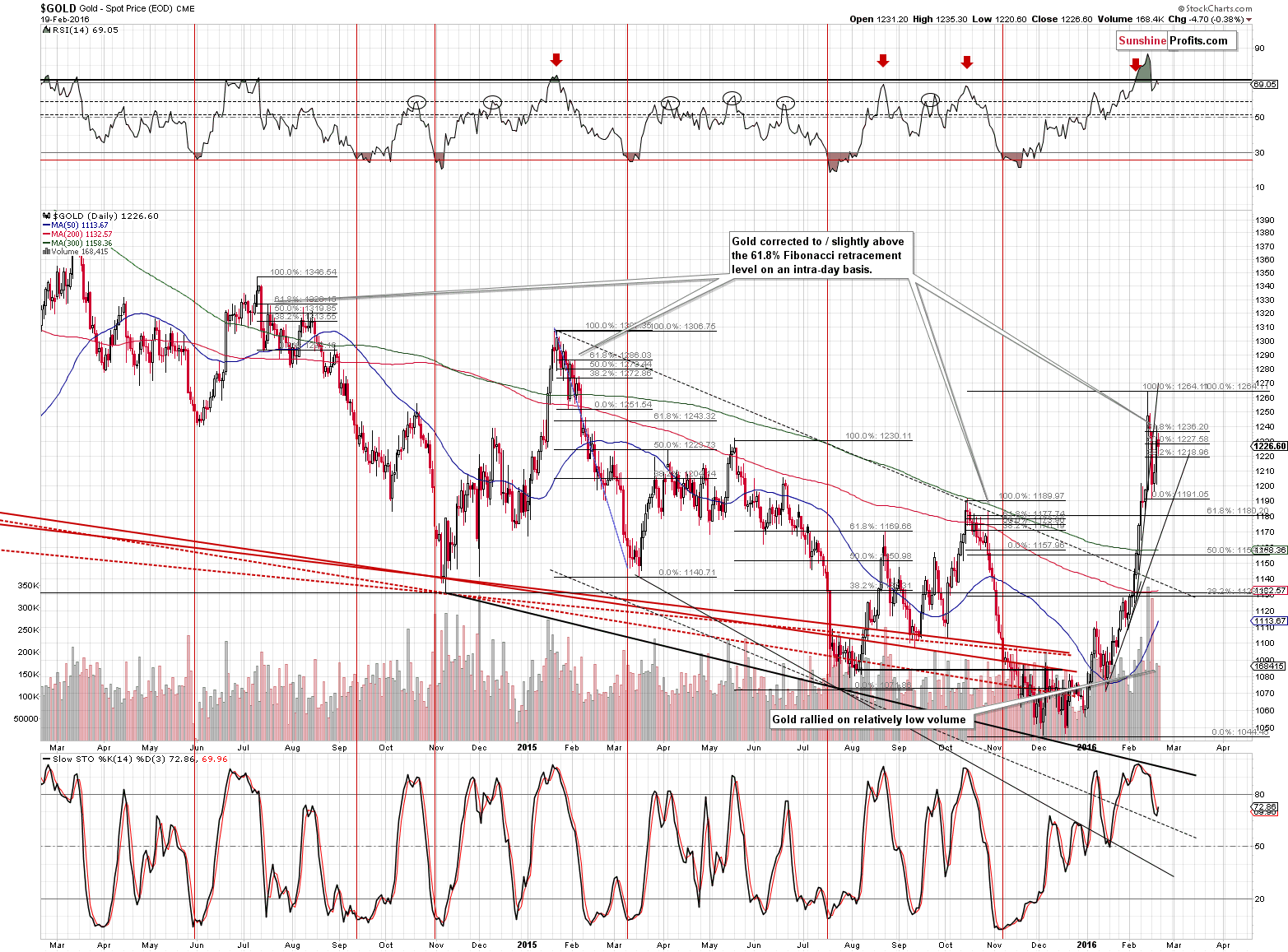
In Friday’s alert we commented on the above chart in the following way:
Moving back to the 61.8% Fibonacci retracement – practically all recent major upswings have ended in this way: the initial top, then a sharp decline and then a corrective – and usually very temporary – upswing to or slightly above the 61.8% Fibonacci retracement. We marked the similar cases on the above chart. What’s next? The decline is likely to resume.
The “bullish” factor that we would like to address is the fact that yesterday’s rally took place along without a decline in the USD Index, which normally implies strength of the gold market. However, we are right after a major upswing and then a sharp downswing and it’s critical to see what happened in previous such cases. Did gold get a boost from the declining USD to correct to the above-mentioned 61.8% retracement? Let’s take a look at the gold chart once again – this time with the USD Index plotted on it.
Thursday’s upswing was indeed accompanied by low volume and Friday’s volume during the small downswing was low as well, but the implications are not analogous – a move lower on low volume is usually meaningless (although it could have some implications in certain situations, but not necessarily in the current case). All in all, the implications of Thursday’s low volume remain in place and they are bearish.
Please note that in 2 previous cases (mid 2014 and early 2015) gold moved back to the 61.8% retracement a few times before the decline truly resumed, so gold’s intra-day move to it on Friday is not a bullish sign.
Moreover, we wrote the following on Friday regarding the fact that gold had moved higher without a decline in the USD Index:
In all 3 cases that we marked on the above chart (the ones that we plotted the Fibonacci retracements for) the corrective upswing in gold materialized without a decline in the USD Index. Even in early 2015 – the upswing in gold took place on the day when the USD did more or less nothing – it declined relatively shortly thereafter, but on the day that gold rallied sharply, it didn’t do much, if anything.
Consequently, the fact that gold rallied yesterday without a decline in the USD Index is not a bullish divergence – it’s the normal way in which gold corrects after the initial sharp slide. Therefore, it is not currently bullish that gold rallied without the USD’s help.
On Friday gold declined along with the USD Index, so the above observation was somewhat confirmed.
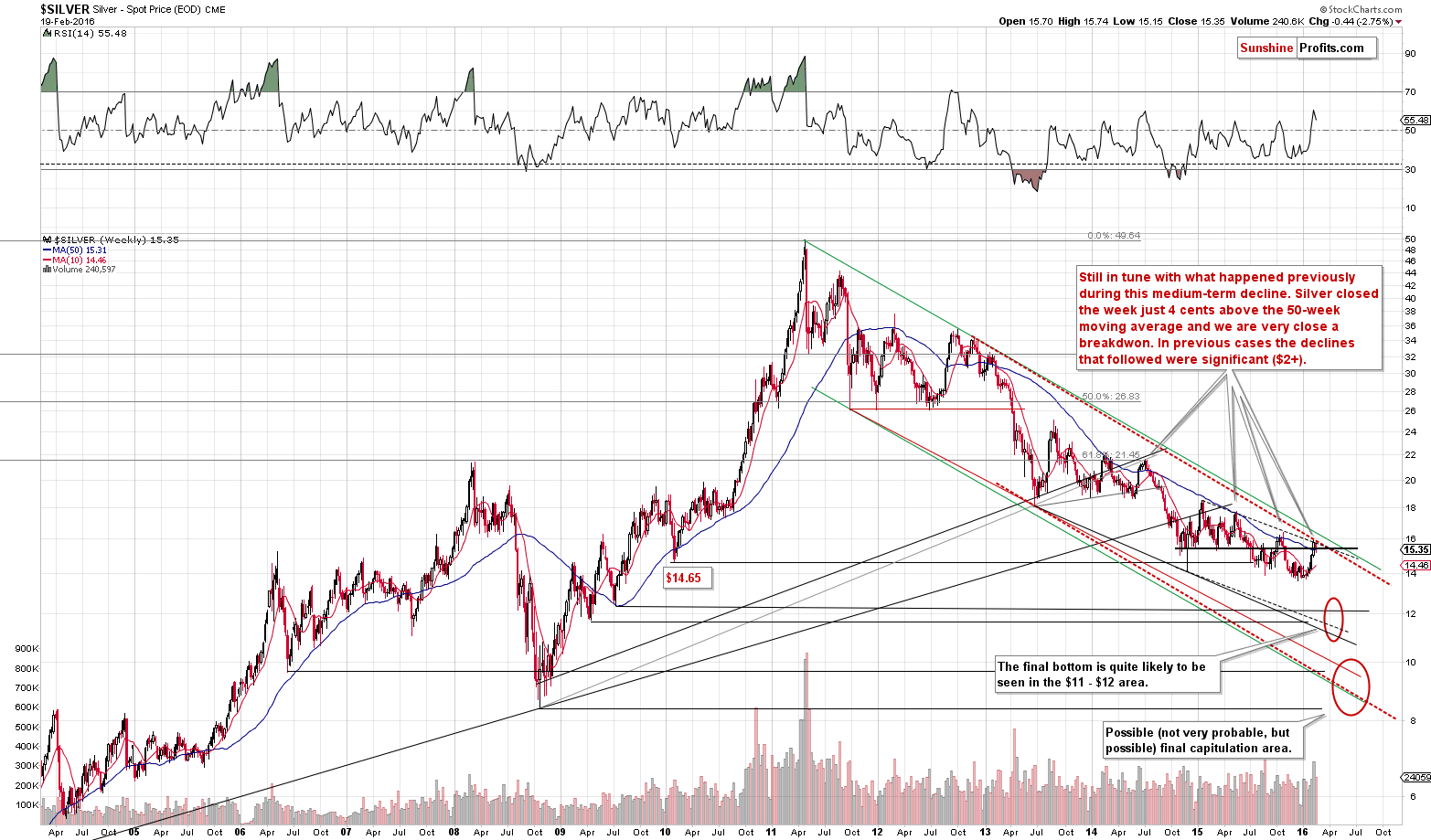
Silver declined 44 cents last week and it closed just a few cents above the 50-week moving average. The move back below it was not confirmed, but we had seen the same thing in mid 2014 (the move above the moving average was not immediately invalidated) and it didn’t matter much – silver still declined over $2 (in fact, it declined over $7 in the following months). The outlook remains bearish.
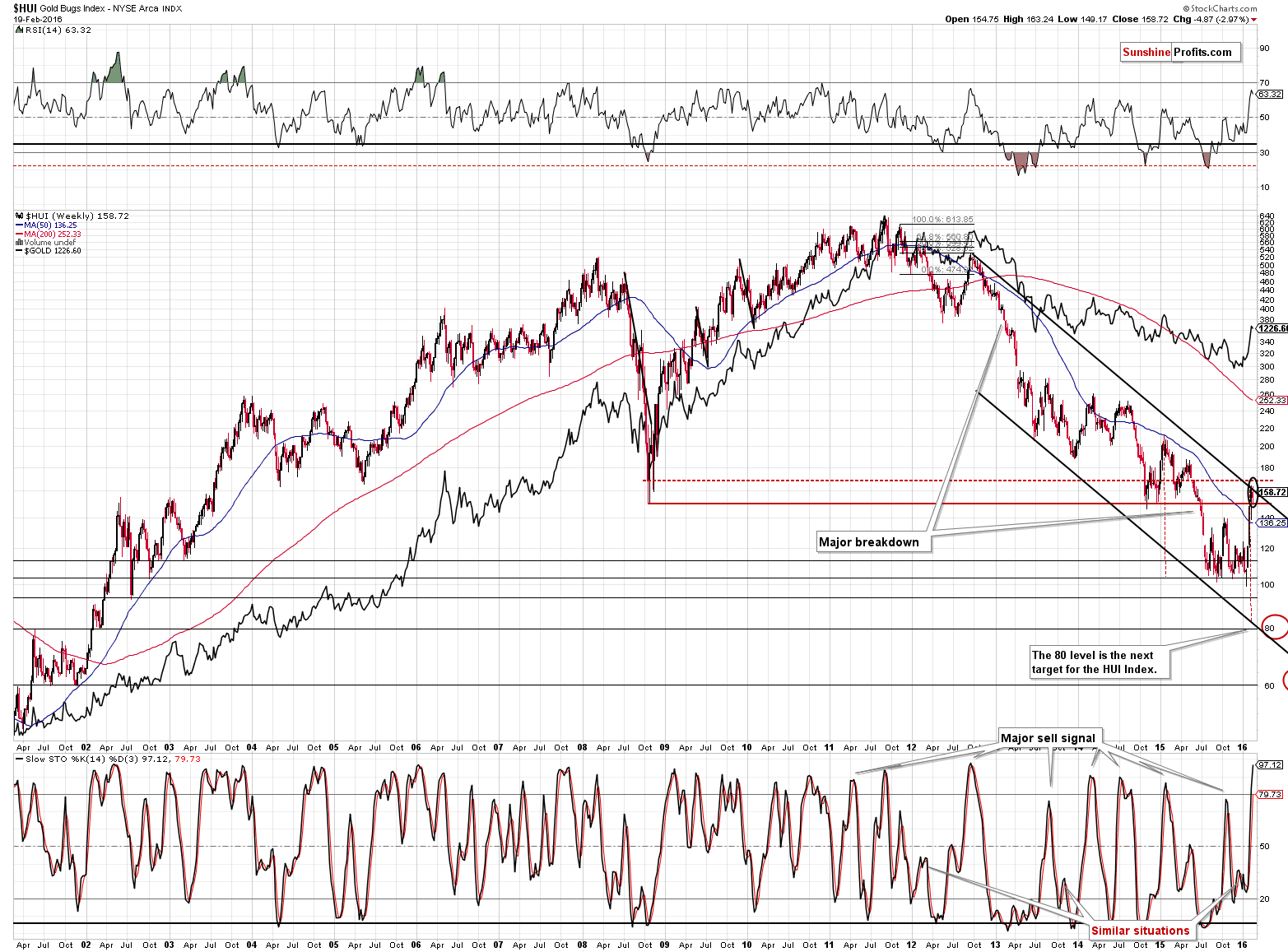
Gold stocks moved higher last week, but they moved only a little above their previous February high. We have previously written that the resistance was between 150 and 170 and the HUI Index closed the week visibly below 170. Consequently, the outlook didn’t improve much based on last week’s rally.
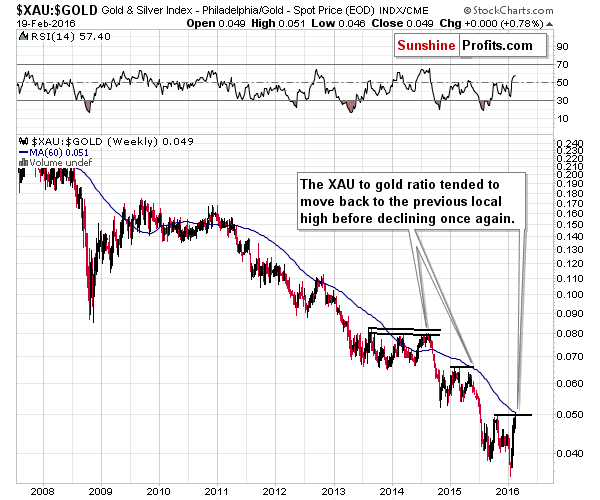
The XAU to gold ratio continues to move in tune with what we saw during previous corrective upswings. At this time the ratio is at the late 2015 top and the 60-week moving average. The odds are that we will see a reversal sooner rather than later (this ratio doesn’t have very short-term implications, though, so if we don’t see a slide this week, it will likely not invalidate the above).
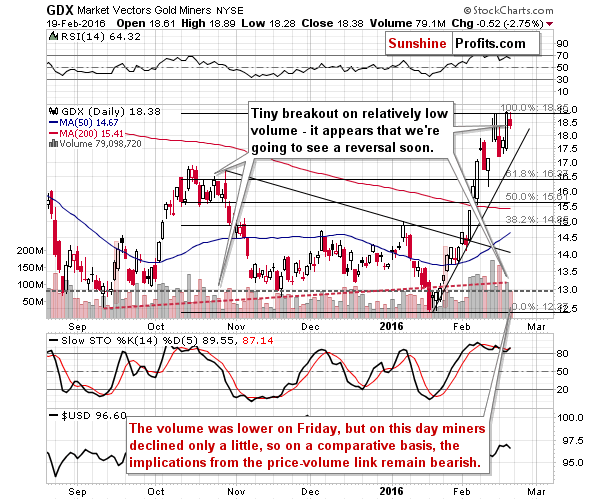
On Friday, we wrote the following:
The GDX ETF rallied significantly and closed a little above the previous high. What’s the problem with this breakout? Everything – it’s not significant, it was not accompanied by significant volume and it was not accompanied by an analogous breakout in the HUI Index. Conversely, the volume was relatively low. It was not as tiny as what we had seen in late December 2016, but comparing the rally to a similar (with regard to size) decline that we saw on Tuesday shows that the volume was indeed much lower yesterday.
From the short-term point of view, we see that the small breakout in the GDX ETF was already invalidated. The volume not huge, but the size of the move was much smaller than what we had seen on Thursday, so overall the fact that GDX rallied much more on Thursday on only a little higher volume is more important and bearish.
On Friday, we also wrote the following:
The mentioned factors are enough to make the outlook much more bearish than it was in the previous days, but there’s also one additional factor. While the volume was not big in the precious metals sector, it appears that a very significant amount of individual investors bought yesterday (or at least was very interested in the precious metals sector). How can we know that? Well, we can’t know for sure without tracking all orders, but we think there is a quite good proxy to see what the current “hot” investment among the investment public is.
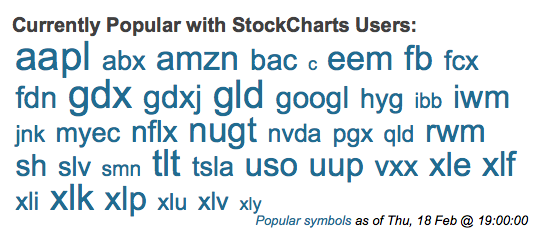
The homepage of stockcharts.com provides a tag cloud where tags are symbols of stocks, ETFs and ETNs that have been most popular recently. Guess what – the most popular symbols are related to the precious metals sector: GLD, GDX, NUGT, and even GDXJ and ABX.
If metals and miners got so popular among individual investors, then why was the volume not huge? Because it was so extremely popular only among small investors – the general public – and not among the most wealthy and institutional investors (on average, of course, there are exceptions in both cases). This is what happens at tops and therefore, the combination of the level of volume and the popularity of precious-metals-related symbols has bearish implications and serves as another bearish confirmation.
The above remains to be the case.
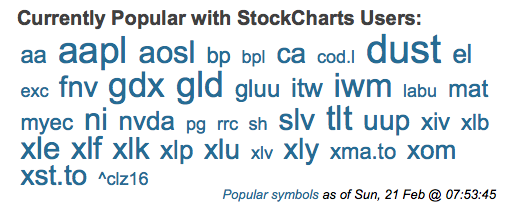
The precious-metals-related symbols remain to be highly popular and the implications remain bearish.
Summing up, it’s likely that precious metals are starting a big decline here, and the short-term outlook deteriorated based on Thursday’s price-volume action while Friday’s price-volume action was rather neutral. Other factors favor lower precious metals prices as well and it seems that the risk to reward ratio is at a level that justifies having a full speculative position open in gold, silver and mining stocks. As always, we will keep you – our subscribers – updated.
As always, we will keep you – our subscribers – updated.
To summarize:
Trading capital (our opinion): Short positions (full) in gold, silver and mining stocks are justified from the risk/reward perspective with the following stop-loss orders and initial target price levels:
- Gold: initial target price: $973; stop-loss: $1,274, initial target price for the DGLD ETN: $94.27; stop-loss for the DGLD ETN $52.44
- Silver: initial target price: $12.13; stop-loss: $16.14, initial target price for the DSLV ETN: $77.53; stop-loss for DSLV ETN $42.69
- Mining stocks (price levels for the GDX ETF): initial target price: $9.34; stop-loss: $19.63, initial target price for the DUST ETF: $17.31; stop-loss for the DUST ETF $4.14
In case one wants to bet on junior mining stocks' prices (we do not suggest doing so – we think senior mining stocks are more predictable in the case of short-term trades – if one wants to do it anyway, we provide the details), here are the stop-loss details and initial target prices:
- GDXJ ETF: initial target price: $14.13; stop-loss: $26.53
- JDST ETF: initial target price: $36.46; stop-loss: $8.34
Long-term capital (our opinion): No positions
Insurance capital (our opinion): Full position
Plus, you might want to read why our stop-loss orders are usually relatively far from the current price.
Please note that a full position doesn’t mean using all of the capital for a given trade. You will find details on our thoughts on gold portfolio structuring in the Key Insights section on our website.
As a reminder – “initial target price” means exactly that – an “initial” one, it’s not a price level at which we suggest closing positions. If this becomes the case (like it did in the previous trade) we will refer to these levels as levels of exit orders (exactly as we’ve done previously). Stop-loss levels, however, are naturally not “initial”, but something that, in our opinion, might be entered as an order.
Since it is impossible to synchronize target prices and stop-loss levels for all the ETFs and ETNs with the main markets that we provide these levels for (gold, silver and mining stocks – the GDX ETF), the stop-loss levels and target prices for other ETNs and ETF (among other: UGLD, DGLD, USLV, DSLV, NUGT, DUST, JNUG, JDST) are provided as supplementary, and not as “final”. This means that if a stop-loss or a target level is reached for any of the “additional instruments” (DGLD for instance), but not for the “main instrument” (gold in this case), we will view positions in both gold and DGLD as still open and the stop-loss for DGLD would have to be moved lower. On the other hand, if gold moves to a stop-loss level but DGLD doesn’t, then we will view both positions (in gold and DGLD) as closed. In other words, since it’s not possible to be 100% certain that each related instrument moves to a given level when the underlying instrument does, we can’t provide levels that would be binding. The levels that we do provide are our best estimate of the levels that will correspond to the levels in the underlying assets, but it will be the underlying assets that one will need to focus on regarding the sings pointing to closing a given position or keeping it open. We might adjust the levels in the “additional instruments” without adjusting the levels in the “main instruments”, which will simply mean that we have improved our estimation of these levels, not that we changed our outlook on the markets. We are already working on a tool that would update these levels on a daily basis for the most popular ETFs, ETNs and individual mining stocks.
Our preferred ways to invest in and to trade gold along with the reasoning can be found in the how to buy gold section. Additionally, our preferred ETFs and ETNs can be found in our Gold & Silver ETF Ranking.
As always, we'll keep you - our subscribers - updated should our views on the market change. We will continue to send out Gold & Silver Trading Alerts on each trading day and we will send additional Alerts whenever appropriate.
The trading position presented above is the netted version of positions based on subjective signals (opinion) from your Editor, and the Tools and Indicators.
As a reminder, Gold & Silver Trading Alerts are posted before or on each trading day (we usually post them before the opening bell, but we don't promise doing that each day). If there's anything urgent, we will send you an additional small alert before posting the main one.
=====
Latest Free Trading Alerts:
According to the U.S. Department of Labor, the core Consumer Price Index (CPI) rose by 0.3 percent in January. Does it mean that inflation is rising, which would bring us closer to the next Fed hike? How can this data affect the gold market?
How Will January CPI Affect Gold?
=====
Hand-picked precious-metals-related links:
COT: Gold longs jump again despite price slump
Russia's January gold reserve increase much higher than previously reported
Gold miners thrive in bleak Q4
AngloGold returns to profit in Q4 as costs drop
=====
In other news:
S&P Proves Unforgiving of Emerging Markets as Poland Gripes
Janet Yellen is wrong. Expansions do die of old age.
Sterling sinks after London mayor joins 'Brexit' camp
Trouble ahead? Euro zone business activity declines further
HSBC Swings to Loss; Subject of SEC Investigation
=====
Thank you.
Sincerely,
Przemyslaw Radomski, CFA
Founder, Editor-in-chief
Gold & Silver Trading Alerts
Forex Trading Alerts
Oil Investment Updates
Oil Trading Alerts



